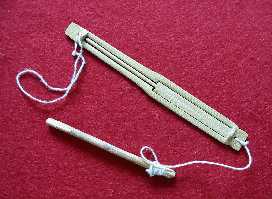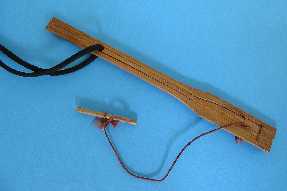|
R E
V I E W S |
France:
guimbarde en bambou, kumbing
Samuel
Mourot
|
|
the
Philippines:
kumbing
Ubo-population

|
(photo: Izz van Elk) This
is a bamboo-wooden Jew's harps made by the collective of Ubo-women living in
the south-eastern part of the island Cotabato in the Philippines. Large-scale
production of a simple bamboo Jew's harp, ornamented with line carvings in
mainly a dark-green color. The kumbings can produce loud and clear
sounds that may surprise you. Very often - and I see it as a defection - the
sound has no sustain and makes the tone too dry and too short. Out of the
world collection of wooden Jew's harps the kumbing is one of the
simplest to play. A wanted object for people in general who are not used to
play. Just a toy (but with joy!) for the (semi)professional. |
|
Thailand
Like
the Philippine kumbing and the Hokkaido mukkuri, the hoon
toung of the A-kha is a prerogative for women, meaning: a very thin Jew's
harp only allowed to be played by the moiety of women. They play it with the
flat side of the frame towards the opened mouth, so the sharp wooden needle
moves into the mouth-cavity as far as possible. |
Bali (
génggong
Wayan Pande

génggong lanang (photo: Izz van Elk)
|
The
first time I came into touch with the Balinese génggong at the Centre
for Ethno-musicology Jaap Kunst, I didn't know what to do with those Jew's
harps with strings and pieces of cotton. With the help from
ethno-musicologist Ernst Heins I've discovered how to handle them. In the
meanwhile (17 years later) I've Iearned to consider the Balinese génggong as
the most powerful instrument of all wooden Jew's harp-types I know. It is a
very rhythmic instrument that can produce intensive tone-colors. It's only a
hell to play on a génggong uninterrupted for a long time. But I played
a lot on it, the most in accompanying the Indonesian music & dance-group Orang
Génggong (= Jew's harp
playing man). Yes, I suffered a lot because of
the stressful tensions by jerking and stabilizing the Jew'sharp with both
hands. I
taught myself to carve génggongs, and I cut several good ones,
depending on the quality of the bamboo-wood I chose. Not every génggong
is a good Jew's harp. In general 80% of all the manufactured génggongs
will be judged as mediocre or less than that. The other 20% will give a good
sound. My opinion is that it depends on what particularly part of the tree or
the plant is chosen: the wet side, a young part, a sunny side, the shadow
part, et cetera. I
came in touch with a dozen of Balinese génggongs and also several engungs,
made by a man called Wayan Pande, living in Sukawati on Bali. It's a
tradition in Probably
it was not the pohon jako (kind of sago-palmwood) itself that made his
génggongs (on which I played) so defective. All the twelve Jew's harps
missed a sort of an elaborated finishing touch. That is what a génggong needs,
for jerking and stabilizising are quite hard jobs. Of one I immediately broke
off the jerking-string - by the way: the strings were all too thin and too
sharp for the hands. I had to correct the whole parcel intensively (see
photo). A pitty, that the man himself didn't do this important work at
all. Click
for: How to play
the génggong |
Bali
génggong lanang
musicians of the group
Panti Pusaka Budaya

génggong lanang (photo: Izz van Elk)
|
I am
the happy owner of one very excellent génggong lanang (high-tuned,
litterly: 'male' Jew's harp) made of the arèn-palmwood. It was made by
a member of the Balinese music & theatre-group Panti Pusaka Budaya,
commanded by the dancer I Made Djimat. Click
for: How to play
the génggong |
Holland:
mondharp,
génggong
Koen
Kuijpers

(photo:
Izz van Elk)
Oblong
génggong with red-colored parts,
cut in stiff bamboo by Koen Kuijpers.
Mongolia
aman
khuur, khulsan khuur
Buryat-population
|
(photo: Izz van Elk) |
Mindanao,
Philippines
kubing

|
(photo: Izz van Elk) |
Kalimantan (Borneo)
gendang untuk mulit
(Dayak-population)

(photo:
Izz van Elk)
|
This
is a very fine gendang untuk mulit from a (here unknown)
Dayak-population in Kalimantan on Borneo. The long Jew's harp was
manufactured somewhere in the 1930-ies. At the tip (right) there are some
carved ornaments. Size: |
Bali
engung

(photo: Izz van Elk)
|
Three engungs from Bali: left and right were manufactured by musicians of the group Panti Pusaka Budaya, in the center is an engung of Wayan Pande. More about this reed: genggong |
|
karombii |
Sulawesi |
Toraja-population |

(photo:
Izz van Elk)
Karombii is the name of this Toraja-Jew's harp
from the Indonesian island Sulawesi. Its principle of
playing can be compared with the Balinese
genggong, but its sound is much more mellow.
Size:

The karombii-maker
Ne'Karombi of the Toraja-population
in Sulawesi playing on a Jew's harp
(photo: Lia v.d. Broek, 1996)
Hear Ne'Karombi play at: http://batusura.de/neka.htm
Papua (former Irian Jaya)
momborsa & toka2
Samarokena-district

(photo: Izz van Elk)
|
Set
of bamboo Jew's harps from Samarokena, Papua (the former Irian Jaya). Usually,
when Jew's harps are kept together as a set, they are parttaking in a ritual
context of courtship or in rites of male adulthood. In Melanesia these sets
are often forbidden to be seen by children or women. The momborsa
(large one) personifies the male's energy, the toka2 (small
one) personifies the female's energy. |
Philippines
alibaw

|
(photo: Izz van Elk) All
references are missing on this alibaw from the Philippines. The half
of the frame (bottom) is just ornamented with brass mounting. Size: |
Maprik, Papua Niugini
binatang
Wam-people

(photo: Izz van Elk)
|
A
large binatang or a sago-beetle from Papua Niugini, which very rare is
used for the function as a living Jew's harp. The player puts the living,
buzzing beetle very close to his opened mouth, so that the harmonics of the
beetle's drone will resonate in his mouth-cavity. On the Antropodium-CD Music and the Dispel of
Thoughts a small binatang can be heard
in a field-recording of Mahisu in Maprik (East-Sepik), made by dr. Robert
MacLennan in 1963 (see front cover of the CD-booklet). The binatang
on this photograph is about |
Bali
těbeng

(photo: Izz van Elk)
|
These
three těbengs (of leather) are not musical instruments, but
attachments for génggong-players. It helps a player to hear his own
sounds better among the louder instruments of the surrounding gamelan. It
will reverberate the sound to (one of) his ears. The player has to hold the
piece of leather in the same hand in which he stabilizes the génggong. Just in front of the embouchure part of the Jew's harp. |
Îles Marquises (Polynesia)
utété

(photo: Izz van Elk)
|
This utété
is a reconstructed, unsophisticated (Jew’s harp-like) mouth instrument of
grassy wood, of which the obsolete originals for the last time were in
popular use among the Polynesians on the Marquises Archipelago in the Pacific
at the end of the nineteenth century. It was described by Curt Sachs in hisTypologische
Vorstudie of 1917. Its
sound evokes the spheres of a grass-like micro-cosmos of chirping insects. It
can be heard on the CD Music
and the Dispel of Thoughts in the Jew's
harp Mosaics-part. |
Vietnam
đan môi sat
montagnards

(photo: Izz van Elk)
|
This is very rare object that carries every aspect of a primtive brass Jew's harp, but it could undoubtly be interchanged for a thing as a hairpin. I miss every clear reference to its background, but it was bought for me in Saigon for a few coins. It is said, that it was manufactured by a montagnard from the north of Vietnam. The sound is mellow, deep, and maybe poor. It has almost no sustain. It is protected by a wrapped piece of paper, carrying a Vietnamese newspaper-text. But seeing this object, and playing on it, is so affective, because there seems to be something magic in this weird object, that on the same time looks like complete empty. One of my real rareties. |
Baliem Valley, Papua (former Irian Jaya)
bigon
Dani-tribes

A small Jew's harp from the Dani-tribes in the valley
of
Baliem-river in Papua, former Irian Jaya (photo: Izz van Elk)
|
In
Melanesia this vernucalar Jew's harp-type is very extensive. It's a small
sized bamboo bigon-Jew's harp from the Baliem-valley, originated by
the Dani-people. |
East-Sepik, Papua Niugini
susap

A large susap from East-Sepik in Papua Niugini
(photo by Izz van Elk)
[ review will follow soon]
to the reviews
of
metal Jew's harps



